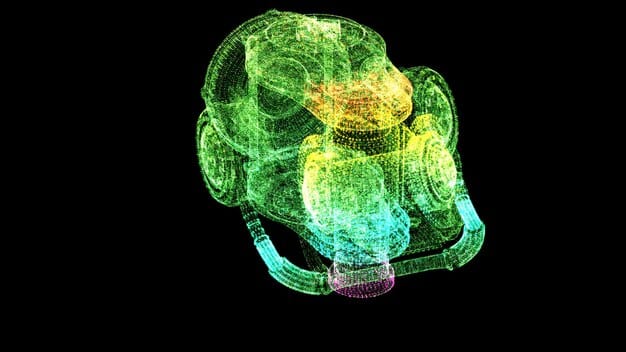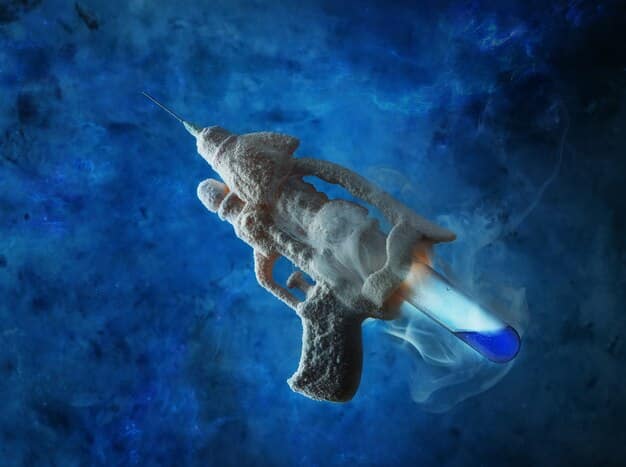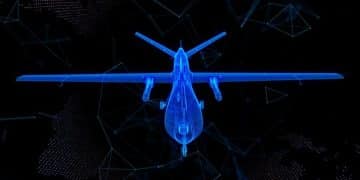US Military’s Nanotechnology: Boosting Soldier Performance

The US military is actively pursuing nanotechnology to significantly enhance soldier capabilities, focusing on improvements in protection, cognitive function, energy efficiency, and overall combat effectiveness through advanced materials and systems.
The concept of the “super soldier” might sound like science fiction, yet advancements in materials science and biotechnology are bringing it closer to reality. A key technological frontier is nanotechnology, which holds immense promise for revolutionizing military capabilities. But how is the US military using nanotechnology to enhance soldier performance, truly pushing the boundaries of what’s possible?
The Nano-Revolution in Soldier Protection
Nanotechnology offers a paradigm shift in protective gear, moving beyond rigid, bulky materials to smart, adaptive solutions. This involves integrating materials at the atomic and molecular scale to create lighter, stronger, and more responsive defenses against various threats.
Traditional body armor, while effective, can be cumbersome, limiting mobility and increasing soldier fatigue. Nanomaterials are poised to change this by offering superior strength-to-weight ratios and dynamic properties.
Advanced Materials for Ballistic Protection
Researchers are exploring how nanoparticles and nanofibers can be woven into textiles to create armor that is both lightweight and incredibly resilient. Imagine a fabric that can harden instantly upon impact, then return to its flexible state.
- Carbon Nanotubes: These cylindrical carbon structures are incredibly strong and lightweight, offering potential for ultra-protective, flexible armor.
- Graphene Composites: A single layer of carbon atoms, graphene is one of the strongest materials known. Its inclusion in composites can significantly enhance ballistic resistance without adding bulk.
- Shear-Thickening Fluids (STF): These fluids contain nanoparticles that cause them to become rigid upon impact, dissipating energy more effectively than traditional materials.
These innovations aim to provide soldiers with enhanced protection against bullets, shrapnel, and other battlefield hazards, all while maintaining agility and reducing the physical burden.
Beyond direct ballistic impacts, nanotechnology also addresses protection against chemical and biological threats. Nanoporous materials can act as highly efficient filters, allowing soldiers to breathe freely while preventing harmful agents from entering their systems. Smart textiles could even detect the presence of dangerous substances and alert the wearer or neutralize the threat.
The goal is to create a multi-layered defense system that is integrated seamlessly into the soldier’s uniform, providing comprehensive protection without compromising performance or comfort. This protective revolution could redefine survivability on the modern battlefield.
Enhancing Cognitive Function and Situational Awareness
Beyond physical protection, the US military investigates nanotechnology’s role in augmenting the soldier’s most critical asset: the mind. This involves improving cognitive processing, decision-making, and overall awareness in high-stress environments.
The battlefield is a dynamic and information-dense environment. Soldiers need to process vast amounts of data, make split-second decisions, and maintain peak mental performance under extreme pressure. Nanotechnology can contribute to achieving this through advanced sensors and neuro-enhancements.
Nano-Sensors for Real-time Data
Miniaturized sensors, built using nanotechnology, can be integrated into helmets, eyewear, and even directly onto a soldier’s skin to collect crucial real-time data. These sensors can monitor physiological parameters, environmental conditions, and even detect threats that are imperceptible to the human eye.
- Biometric Monitoring: Nano-sensors can track heart rate, respiration, body temperature, and stress levels, providing critical health data and flagging potential issues like fatigue or dehydration.
- Environmental Sensing: Detectors for chemical, biological, radiological, and nuclear (CBRN) threats or even environmental toxins can be embedded into gear, offering early warnings.
- Enhanced Vision Systems: Nanomaterials can create lighter, more energy-efficient night vision devices or even integrate thermal imaging capabilities directly into contact lenses.
This constant stream of data, processed by integrated AI systems, can provide soldiers with an unparalleled level of situational awareness, allowing them to anticipate threats and react more effectively.

Furthermore, research into neuro-nanotechnology explores more direct methods of cognitive enhancement. This sensitive area involves interfaces that could potentially improve memory, learning, and reaction times. While still largely in the experimental phase, such advancements could fundamentally alter how soldiers interact with information and adapt to complex combat scenarios.
The ethical implications surrounding direct neural interfaces are significant and form a crucial part of ongoing discussions. However, the potential for non-invasive cognitive support through enhanced visual and auditory inputs, powered by nanomaterials, is much closer to implementation.
Nanotechnology in Energy and Power Solutions
Energy is the lifeblood of modern military operations. Soldiers carry increasing amounts of electronic gear, each requiring its own power source. Nanotechnology offers revolutionary solutions for more efficient, lighter, and long-lasting energy storage and generation.
The current logistical burden associated with batteries and fuel is immense. Reducing this burden can directly impact mission duration, soldier endurance, and operational flexibility.
Next-Generation Batteries and Power Sources
Nanomaterials can significantly improve the performance of batteries, making them smaller, lighter, and capable of holding more charge. This directly translates to less weight for soldiers to carry and longer operational periods for their electronic devices.
- Lithium-Ion Batteries with Nano-Structured Electrodes: These can store more energy and charge faster than traditional lithium-ion batteries.
- Flexible, Wearable Power Sources: Nanomaterials allow for batteries and solar cells to be integrated directly into fabrics, converting uniforms into self-powering systems.
- Thermoelectric Nanomaterials: These can convert waste heat from the body or equipment directly into electricity, providing a continuous, passive power source.
Imagine a uniform that not only protects but also powers all the soldier’s electronic devices through embedded flexible solar cells and thermoelectric generators. This dramatically reduces the need for external battery packs and resupply chains.
Beyond traditional batteries, the military is also exploring advanced compact power generation. Nano-thermoelectric devices, for example, can convert body heat directly into usable electricity, turning the soldier into a walking power station for low-power devices. Fuel cells utilizing nanomaterials can also offer high energy density and quiet operation, critical for stealth and extended missions.
These energy solutions extend beyond the individual soldier to larger platforms, such as unmanned aerial vehicles (UAVs) and ground robots, enabling longer flight times and operational endurance without frequent recharging or refueling.
Advanced Medical and Health Applications
In the austere and often dangerous environments of military operations, rapid and effective medical care is paramount. Nanotechnology promises significant advancements in diagnostics, treatment, and even preventative medicine, directly enhancing soldier health and recovery.
From the point of injury to long-term rehabilitation, nanomedicine offers precision and versatility previously unattainable.
Targeted Drug Delivery Systems
Nanoparticles can be engineered to deliver drugs directly to affected cells or tissues, minimizing side effects and maximizing therapeutic efficacy. This is particularly crucial for treating infections, pain, and traumatic injuries on the battlefield.
- Smart Nanocontainers: These can release medication only when specific biological triggers are present, ensuring precise dosing and reducing systemic exposure.
- Nanobots for Internal Repair: While still largely theoretical, the concept of microscopic robots performing internal repairs or clearing blockages is an area of intense research.
- Advanced Wound Healing: Nanofiber scaffolds can promote faster and more effective tissue regeneration, potentially reducing scarring and infection risk in severe wounds.
Imagine a soldier sustaining an injury, and a patch embedded with nano-enabled diagnostics immediately assesses the damage and administers targeted medication, even before reaching definitive medical care. This could be a game-changer for survivability.

Nanotechnology also plays a role in rapid diagnostics. Handheld devices incorporating nano-sensors can quickly identify pathogens, toxins, or even internal injuries with high accuracy, enabling immediate and appropriate medical intervention. This is invaluable in remote locations where access to sophisticated medical equipment is limited.
Moreover, nanomedicine extends to preventative measures, such as advanced vaccines or prophylactic treatments delivered via nanoparticles, providing enhanced protection against biological threats or common debilitating ailments encountered during deployment.
Stealth, Camouflage, and Communication
The ability to remain undetected while maintaining robust communication is critical for modern military operations. Nanotechnology offers revolutionary approaches to stealth, adaptive camouflage, and highly secure, efficient communication systems.
Traditional methods for concealment often involve trade-offs in mobility or visual acuity. Nanomaterials can overcome these limitations, providing dynamic and superior methods of evasion and data transfer.
Adaptive Camouflage and Signature Management
Nanomaterials can create “smart” surfaces that dynamically change properties to match the environment, rendering soldiers almost invisible across visible, infrared, and even thermal spectra. This goes far beyond static camouflage patterns.
- Metamaterials: Engineered to manipulate electromagnetic waves, metamaterials can potentially bend light around objects, making them optically invisible.
- Plasmonic Nanoparticles: Can be used in coatings to absorb or reflect specific wavelengths, allowing for adaptive thermal and infrared camouflage.
- Chromogenic Nanoparticles: These can change color and texture in response to electrical signals or environmental cues, creating truly dynamic camouflage.
This adaptive camouflage could allow soldiers to seamlessly blend into any terrain, from dense jungle to arid desert, significantly reducing their detection probability. The ability to control thermal signatures is equally crucial, as many modern sensors rely on heat detection.
For communication, nanotechnology enables smaller, more powerful, and more secure transceivers. Nano-antennas can be far more efficient and compact, allowing for high-bandwidth communication on the move without compromising stealth.
Furthermore, research into “nanocommunication networks” explores the potential for microscopic, self-assembling communication nodes that could form resilient, ad-hoc networks in contested environments. Such decentralized systems would be far more robust against jamming and interception, ensuring critical data flows even under adverse conditions.
Integrating these stealth capabilities directly into uniforms and equipment means soldiers can operate with greater confidence and effectiveness in enemy territory, transforming the dynamics of reconnaissance and special operations.
Ethical Considerations and Future Prospects
While the potential benefits of nanotechnology for soldier enhancement are profound, the development and deployment of these technologies raise significant ethical, legal, and societal questions. Navigating these challenges is as critical as the scientific research itself.
The concept of “human enhancement” often triggers discussions about fairness, identity, and the very definition of a soldier.
Balancing Breakthroughs with Responsibility
One of the primary ethical concerns revolves around the long-term health implications of integrating advanced nanomaterials or neuro-interfaces with the human body. Ensuring the safety and well-being of soldiers remains paramount.
- Long-term Health Monitoring: Robust and continuous studies are essential to understand any latent effects of chronic exposure or integration of nanomaterials.
- Informed Consent: As with any experimental medical or performance-enhancing technology, the principle of fully informed and voluntary consent for soldiers participating in trials is crucial.
- The “Humanity” Question: Questions arise about how far enhancement should go before it alters the fundamental nature of what it means to be human or a soldier.
Another debate centers on equity and access. If certain enhancements become highly effective, what are the implications for soldiers who do not have access to them, or for international relations if only some militaries possess such capabilities?
The future prospects of nanotechnology in the military are vast, extending into autonomous systems, advanced manufacturing, and space exploration. From self-healing materials for vehicles to intelligent swarms of nanobots for reconnaissance, the applications are continuously expanding.
The US military’s investment in nanotechnology underscores a broader vision of maintaining technological superiority. However, responsible innovation, underpinned by thorough ethical review and public discourse, will be essential to ensure these powerful technologies serve humanity’s best interests while enhancing defense capabilities.
The ongoing dialogue between scientists, ethicists, policymakers, and military leaders will shape the trajectory of these transformative technologies, ensuring that the enhanced soldier remains a protector, not merely a product of advanced engineering.
| Key Point | Brief Description |
|---|---|
| 🛡️ Soldier Protection | Developing lighter, stronger body armor and uniforms with enhanced ballistic and CBRN protection. |
| 🧠 Cognitive Enhancement | Integrating nano-sensors for real-time biometric and environmental monitoring, aiding decision-making. |
| ⚡ Energy Solutions | Creating lighter, higher-capacity batteries and energy harvesting systems for prolonged operations. |
| 🩺 Medical Applications | Enabling rapid diagnostics, targeted drug delivery, and advanced wound healing on the battlefield. |
Frequently Asked Questions About Military Nanotechnology
The primary goal is to significantly boost soldier capabilities and survivability by manipulating materials at the atomic and molecular scales. This includes enhancing protection, cognitive function, energy independence, medical care, and stealth, thereby improving overall combat effectiveness and reducing logistical burdens for the individual soldier.
Nanotechnology enables the creation of lighter, stronger, and more flexible body armor using materials like carbon nanotubes and graphene. It also facilitates adaptive camouflage systems and protective layers against chemical and biological threats, increasing resilience without hindering mobility or adding significant weight to the soldier’s gear.
While true optical invisibility remains largely theoretical, nanotechnology can develop adaptive camouflage systems. These systems use nanomaterials to dynamically change color, texture, and thermal signatures to match the surroundings across various spectra including visible light, infrared, and thermal, making soldiers much harder to detect by conventional and advanced sensors.
Nanotechnology promises more efficient and lighter energy solutions. This includes advanced lithium-ion batteries with increased capacity and faster charging, flexible power sources integrated into uniforms (like solar cells), and thermoelectric materials that convert body heat into electricity. These innovations reduce the reliance on external power packs and extend operational endurance.
Yes, significant ethical concerns exist. These include the long-term health implications of integrating nanomaterials with the human body, the debate over human enhancement and its impact on identity, and issues of equitable access to such advanced technologies among military personnel and nations. Responsible development and clear ethical guidelines are crucial.
Conclusion: The Future of the US Soldier, Nano-Enhanced
The US military’s embrace of nanotechnology signals a profound shift in how soldier effectiveness is conceived and pursued. From revolutionary protective gear and cognitive augmentation to self-sufficient energy systems and precision medical interventions, nanotechnology is set to redefine the capabilities of the individual combatant. This technological frontier promises not just incremental improvements but transformative advancements that could directly impact survivability, operational endurance, and strategic outcomes. However, as with all groundbreaking innovations, the journey is fraught with complex ethical and practical considerations, requiring careful navigation to ensure these powerful tools are wielded responsibly and humanely. The nano-enhanced soldier is emerging not merely as an object of science fiction, but as a carefully engineered reality, poised to face the challenges of tomorrow’s battlefields with unprecedented capability.





